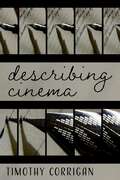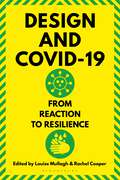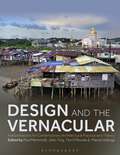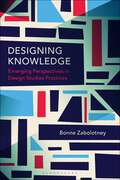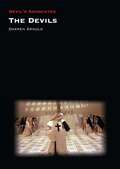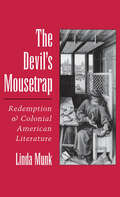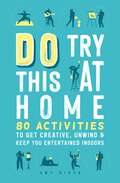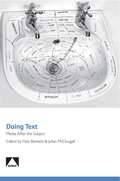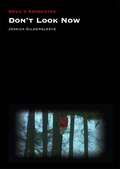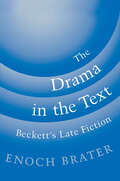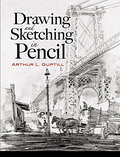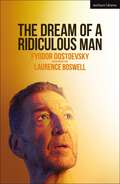- Table View
- List View
Describing Cinema
by Timothy CorriganIn Describing Cinema, award-winning film scholar Timothy Corrigan explores the art and poetics of writing about film. Part theory, part rhetoric, and part pedagogy, the text examines and demonstrates acts of describing scenes, shots, and sequences in films as the most common and most underestimated way viewers respond to movies. Describing Cinema represents a global range of movies from Hollywood to Morocco to Rome, made from the 1940s to the present. As Corrigan shows, energetic and careful descriptions can serve as exceptionally rich ways to demonstrate and celebrate the activities, varieties, and challenges of a central generative movement in the viewing and interpretation of films. At its best, the act of describing films never simply denotes actions, images, sounds, or styles but rather produces the orchestration of one or more of those dimensions as an often creative and intersubjective movement between images, viewers, and a rhetorical language. Providing an invaluable exploration of the challenges and rewards film scholars face in describing movies, Corrigan insists that writing about film becomes thinking about film.
Design and Covid-19: From Reaction to Resilience
Presenting key examples and case studies of how design has responded to the pandemic, Design and Covid-19 offers lessons and approaches to design for future resilience. Design has a key role to play in not only creating products to ensure safety from the pandemic, but also in the creation of complex systems, new technologies and physical environments that enable us to carry out our lives and protect populations in the future. Design and Covid-19 identifies four key phases of the pandemic to examine how designers developed systems, services, communications and products as part of our response to the crisis, whether at an international, national or community level. Contributors report from a range of international contexts, including countries in Europe, Asia, Africa and Australasia, detailing how countries responded to the pandemic, introduced social distancing and lockdowns, developed test, track and trace systems, implemented new laws and how design and designers responded to the urgent new challenges that the pandemic created. They explore the adaptation of designs as communities searched for new ways of connecting and working through restrictions and social distancing measures, establishing local mutual aid groups and using social media to support each other through the pandemic, and go on to focus on recovery and resilience, analysing the deeper, systemic design response as industries emerge from lockdown. They explore the need to reflect on and investigate key issues in order to understand what we can learn personally, socially, economically and globally from this unprecedented crisis. Drawing upon the expertise of scholars from across the globe, Design and Covid-19 explores a wide range of design disciplines to address the complex societal and global issues highlighted throughout the pandemic, and to inform new ways of building human and planetary wellbeing.
Design and the Vernacular: Interpretations for Contemporary Architectural Practice and Theory
Design and the Vernacular explores the intersection between vernacular architecture, local cultures, and modernity and globalization, focussing on the vast and diverse global region of Australasia and Oceania. The relevance and role of vernacular architecture in contemporary urban planning and architectural design are examined in the context of rapid political, economic, technological, social and environmental changes, including globalization, exchanges of people, finance, material culture, and digital technologies. Sixteen chapters by architects designers and theorists, including Indigenous writers, explore key questions about the agency of vernacular architecture in shaping contemporary building and design practice. These questions include: How have Indigenous and First Nations building traditions shaped modern building practices? What can the study of vernacular architecture contribute to debates about sustainable development? And how has vernacular architecture been used to argue for postcolonial modernisation and nation-building and what has been the effect on heritage and conservation? Such questions provide valuable case studies and lessons for architecture in other global regions -- and challenge assumptions about vernacular architecture being anachronistic and static, instead demonstrating how it can shape contemporary architecture, nation building and cultural identities.
Design Culture in Liverpool 1888-1914: The Origins of the Liverpool School of Architecture
by Christopher CrouchBy the 1930s the Liverpool School of Architecture was the most famous British school of architecture in the world, promoting modern architecture and city planning internationally. This book looks at the cultural environment in Liverpool at the turn of the twentieth century which enabled such an important institution to come to fruition. It examines attitudes towards design practice through the work of patrons, practitioners, institutions and theorists in the city, and considers the way their ideas were formed by national and international trends. From a city microcosm of contesting design aesthetics emerged a unique synthesis that was to exert a profound international influence in architectural and planning design.
Design Guidelines in American Cities: A Review of Design Policies and Guidance in Five West-Coast Cities (TPR [Town Planning Review] Special Studies #2)
by John PunterThis book is a study of design initiatives and policies in five US West Coast cities — Seattle (including Bellevue), Portland, San Francisco, Irvine and San Diego—all of which have had particularly interesting urban design experience of relevance to practice in Britain and other countries. Although these cities are not a representative sample of all American design practice, they provide a rich vein of ideas about recent policy development and current initiatives which will stimulate thought about the formulation of effective design controls. The presentation of substantial extracts from key documents that underpin design controls in the five cities will be of interest, inspiration and practical use to academics and practitioners who want to know more about American practice and who want to contribute to improvements in the standards and quality of urban design policies and design control. The opening chapter provides a national context and a comparative framework for the study, with a focus on international perspectives, American planning systems and the development of criteria for comparison and evaluation. The five subsequent chapters take each city in turn, briefly reviewing the salient characteristics of each one before presenting an account of how planning and design policy have evolved in the last twenty-five years; key features of the contemporary systems of design control are highlighted and a summary evaluation is made. The focus in the case studies is on how policy and guidance have been formulated, structured and presented in the various documents that make up the policy framework, how the process of control operates, and how both respond to the criticisms commonly made of design and control. This final chapter draws general conclusions about the experience of the studied cities of wider relevance to American design review practice, but which are of interest to those engaged in design review and policy formulation everywhere.
Design, Manufacture and Sell Your Bag Collection
by Ann SaundersTurn your passion and inspiration into a must-have bag collection and launch your own successful brand.Handbag design is more than just a creative pursuit-it's also a business. This book is a practical guide to developing your design skills alongside the vital business know-how you'll need to avoid costly mistakes. Ann Saunders leads you through the whole process from initial concepts through to sampling, manufacturing, marketing, and retail. You'll learn how to navigate the challenges of sourcing materials, finding a manufacturer, creating a bespoke brand, developing a sales strategy, and growing your business.Throughout the book Ann's former students, who have established their own successful brands, share their real-world insights into the challenges of becoming a designer/entrepreneur in today's highly competitive accessories market. With more than 150 images, charts and illustrations, Design, Manufacture and Sell Your Bag Collection includes detailed advice on:The Creative Process, Researching Your Brief, Knowing Your Customer, Designing Your Bag, Critical Paths, Materials, Hardware, Understanding Bag Construction, Completing Your Design, Planning a Range, Sampling, Manufacturing, Branding, Marketing, Business Planning, Sustaining Your Business, and Sustainability
Designing Gender: A Feminist Toolkit
by Dr Sarah Elsie BakerThis book offers an ideal first step for designers looking to disrupt contemporary design practice by challenging gender inequality. Drawing on feminist and queer theory, it outlines key concepts and applies them to a broad spectrum of design activity. By developing feminist design approaches and methods, it provides a practical resource for designers wanting to make a change. Designing Gender covers essential topics including definitions of sex, gender and sexuality, histories of women in design, parity in professional design practice, diversity of users, non-binary design approaches, and sustainable and equitable futures. Filled with examples from around the world, the book recognises the culturally specific nature of gendered experience. Interviews with designers working in a diverse range of fields including user experience design, visual communication, interaction design and critical design, highlight the challenges and opportunities involved in designing a more equitable society. Each chapter showcases key methods and tools and culminates in hands-on activities.
Designing Knowledge: Emerging Perspectives in Design Studies Practices
By positioning designers and their practices at the center of design studies, Designing Knowledge merges theory and practice to highlight how knowledge creation can contribute to an expanded and more inclusive design practice. Bringing together a rich variety of perspectives, methods and approaches, and by exploring and critiquing current issues in design studies, this book encourages designers to reflect on their work in a new light. Design studies practice is a material and tangible focus on knowledge production and mobilization in the field of design. Throughout 15 chapters featuring a wide range of case studies, design practitioners and theorists address how they produce and mobilize knowledge about design through their practice. Chapters explore how to dismantle the colonial structures of modernist design and depart from the privileged spaces of art historical concepts in design history. They address tensions between traditional Indigenous design and contemporary design practice, discuss how to authentically integrate personhood into practice and explore topics such as designing wellbeing, developing communities of care, informed accountability and principles of the ecocene. They also analyse languages and typographic representations and investigate the nature of the graphic and typographic translation of literary texts, focusing on the writing of Argentinian writer Jorge Luis Borges as a case study.This book elevates the voices of designers and their work and offers insights to professional designers as well as students on how to use these contributions when working on future projects. By highlighting the awareness of designers throughout their practice, this book will inspire others to reflect on their work and share their own knowledge for the benefit of the field of design.
Designing the Domestic Posthuman
by Colbey Emmerson Reid Dennis M. WeissEver since TIME magazine's 1983 'Man of the Year' was the PC, we have been led to believe that our domestic spaces have been colonized by digital technology. Too little attention has been paid to the domestic spaces and inhabitants impacted by this, and critical posthumanism has been captured by a picture of humanity overly indebted to digital technologies and their largely male progenitors. By applying feminist theory to posthumanism, this work recovers the plethora of sophisticated human-technology mediations associated with the home and practiced primarily by women, the elderly, infants, the disabled and across cultures globally, challenging dominant, contemporary visions of a future humanity.Authors Dennis M. Weiss and Colbey Emmerson Reid look at various iterations of the posthuman and assert the need for alternative, feminist readings that emphasize different standpoints from which to assess people, places, and products. Chapters address the impact of posthumanism on design theory and look at familiar domestic objects, with different attributes from those typically affiliated with technology and the future, such as clothing, textiles, ceramics, furniture and wallpaper. They reveal their unhomely, extra-human qualities and offer a much-needed perspective on domestic spaces and practices, revivifying the home as a site of species transformation and pushing beyond traditional understandings of person, mothering, families and care-giving to highlight a range of critically-overlooked mediated materialisms and embodiments affiliated with domestic space.By focusing on the neglected intersection of the posthuman with the home and exploring domestic posthuman design, Designing the Domestic Posthuman offers a vision of a future humanity that retains identity, integrity and considers our relationship to others, to the world and things in it. This book widens the lens of critical focus in posthumanism, feminist philosophy and design and presents an alternative, inclusive design framework for the future.
Designs for Street Fronts, Suburban Houses and Cottages (Dover Architecture)
by C. C. Miller M. F. CummingsExcellent sourcebook includes elevations of building fronts as well as enlarged drawings of architectural elements incorporated in these facades: residential entrances, cornices, a curved roof, dormer window, and much more. Indispensable archive for preservationists, restorationists, architectural historians, and urban archaeologists. 714 illustrations on 52 plates.
Destiny: A Novel in Pictures (Dover Fine Art, History Of Art Series)
by Otto NückelIn an arresting series of images, the story of a young woman's tragic, often violent, life unfolds. Follow her as she lives out her destiny through seventeen chapters, including Childhood, The Father, The Mother, Service, Love, Vengeance, The Seducer, and The Crime. Each visual dimension of her world is a riveting discovery.In the style of genre masters Frans Masereel and Lynd Ward, Nückel's graphic novel pulses with movement and a vivid unspoken life. No words are needed to accompany the 188 stark black-and-white illustrations: the pictures speak for themselves. This stunning pictorial narrative, open to endless interpretation, is charged with a page-turning power by each memorable and hypnotic drawing. <P><P> <i>Advisory: Bookshare has learned that this book offers only partial accessibility. We have kept it in the collection because it is useful for some of our members. Benetech is actively working on projects to improve accessibility issues such as these.</i>
The Devils (Devil's Advocates)
by Darren ArnoldUndoubtedly the most notorious title in director Ken Russell’s controversial filmography, The Devils (1973) caused a real furor on its initial theatrical release, only to largely disappear for many years. This Devil’s Advocate considers the film’s historical context, as the timing of the first appearance of The Devils is of particular importance, its authorship and adaptation (Russell’s auteur reputation aside, the screenplay is based on John Whiting’s 1961 play of the same name, which was in turn based on Aldous Huxley’s 1952 book The Devils of Loudun), and its generic hybridity. Darren Arnold goes on to examine the themes prevalent in the film—this is the only film of Russell’s which the director considered to be political—and considers the representation of gender and sexuality, gender fluidity, and how sex and religion clash to interesting and controversial effect. He concludes by revisiting the film’s censorship travails and the various versions of The Devils that have appeared on both big and small screens, and the film’s legacy and influence.
Dialogues with Degas: Influence and Antagonism in Contemporary Art
by Dr. Kathryn BrownDialogues with Degas demonstrates the ongoing relevance of Edgar Degas to 20th- and 21st-century ideas and art practices.The first in-depth examination of this major artist's impact on contemporary art, this book explores how contemporary practitioners have used Degas's creativity as a springboard to engage imaginatively and critically with themes of colonialism, gender, race and class. Individual chapters are devoted to dialogues between Degas's art and works produced by Frank Auerbach, Cecily Brown, Xinyi Cheng, Ryan Gander, Maggi Hambling, Damien Hirst, Howard Hodgkin, Chantal Joffe, Leon Kossoff, R.B. Kitaj, Juan Muñoz, Paula Rego, Jenny Saville, Yinka Shonibare, Cy Twombly and Rebecca Warren.Through close analyses of selected paintings, drawings, prints and sculptures, Kathryn Brown explores how Degas's technical and compositional experiments have been extended or challenged in innovative ways. By experimenting with the materials and methods of existing works, contemporary artists generate visual palimpsests that make new demands of the viewer and prompt a reconsideration of ideas that have informed histories of 19th-century French art.The book overturns familiar conceptions of influence by eschewing a genealogical approach and prioritizing, instead, the analysis of non-linear encounters between artworks. This encourages a new conception of the agency of visual artefacts and of the conversations they are capable of entertaining with each other. While this study sheds new light on Degas's art and that of his interlocutors, it also has methodological significance for the writing of art history.
Die mehreren Wehmüller und ungarischen Nationalgesichter
by Clemens BrentanoThe traveling painter Wehmüller invented the art of Schnellporträtierens. He paints the people before he sees them. Clemens Brentano has a firework in his first published in 1817 narrative - sparked joke - knowledge-creating. Motifs and storylines are funny and profoundly interwoven. illustrate the drawings by Karl-Georg Hirsch and densify the bizarre and grotesque scenes of the narrative; Hans Magnus Enzensberger described the contemporary historical and philosophical background of this satirical piece Cabinet.
Do Try This at Home: 80 Activities to Get Creative, Unwind and Keep You Entertained Indoors
by Amy BirchStaying at home doesn’t mean that you have be stuck in front of the TV. This is the ultimate companion to help you beat boredom and to embrace your time indoors.Organized by mood, this book is packed with ideas on how to energize yourself, find your purpose, relax and reflect, get creative and connect with the world around you. Whether it’s for a rainy day or a weekend indoors, there are over 80 ideas to keep busy and to challenge your mind. Staying at home can be a challenge and this clever book will offer ways to keep you happy and healthy, from putting together a homemade exercise routine using everyday household items to creating your own home silent disco as well as ideas to help you discover a new hobby, such as learning a language or upcycling furniture. There are also tasks to keep you feeling engaged and proactive, with tips on lowering your plastic pollution and ways you can volunteer from the comfort of your home, as well as practical ways to help you stay connected with nature, from making your own bird feeder to star gazing from your window, and creative activities to help reduce stress and worry, such as journaling, colouring and crafting. Staying in is the new going out, and it’s so much more fun when you have ideas to keep you busy and entertained. These simple activities are full of tips and tricks to make your time at home as enjoyable as possible. You’ll never wonder what you can do with your spare time ever again!
Doing Text: Media After the Subject (Auteur)
This collection re-imagines the study of English and media in a way that decentralises the text (e.g. romantic poetry or film noir) or media formats/platforms (e.g. broadcast media/new media). Instead, the authors work across boundaries in meaningful thematic contexts that reflect the ways in which people engage with reading, watching, making, and listening in their textual lives. In so doing, this project recasts both subjects as combined in a more reflexive, critical space for the study of our everyday social and cultural interactions. Across the chapters, the authors present applicable learning and teaching strategies that weave together art works, films, social practices, creativity, 'viral' media, theater, TV, social media, videogames, and literature. The culmination of this range of strategies is a reclaimed 'blue skies' approach to progressive textual education, free from constraining shackles of outdated ideas about textual categories and value that have hitherto alienated generations of students and both English and media from themselves.
Don't Look Now (Devil's Advocates)
by Jessica GildersleeveNicolas Roeg's Don't Look Now (1973) has been called "a ghost story for adults." Certainly, in contrast to the more explicitly violent and bloodthirsty horror films of the 1970s, Don't Look Now seems of an entirely different order. Yet this supernaturally inflected tale of a child's accidental drowning, and her parents' desperate simultaneous recoil from her death and pursuit of her ghost, Don't Look Now is horrific at every turn. This book argues for it as a particular kind of horror film, one which depends utterly on the narrative of trauma—on the horror of unknowing, of seeing too late, and of the failures of paternal authority and responsibility. Jessica Gildersleeve positions Don't Look Now within a discourse of midcentury anxiety narratives primarily existing in literary texts. In this context, it represents a cross over or a hinge between literature and film of the 1970s, and the ways in which the women's ghost story or uncanny story turns the horror film into a cultural commentary on the failures of the modern family.
The Drama In The Text: Beckett's Late Fiction
by Enoch BraterThe Drama in the Textargues that Beckett's late fiction, like his radio plays, demands to be read aloud, since much of the emotional meaning lodges in its tonality. In Beckett's haunting prose work the reader turns listener, collaborating with the sound of words to elucidate meaning from the silence of the universe. Enoch Brater ranges across all of Beckett's work, quoting from it liberally, and makes connections mainly with other writers, but also with details drawn from the entire Western cultural heritage. Brater serves as an authoritative and persuasive guide to the rich texture of such a difficult but compelling vocabulary, providing recognition, insight, and accessibility.
Drawing and Sketching in Pencil (Dover Art Instruction)
by Arthur L. GuptillThis classic guide offers clear, concise instruction in the basics as well as the finer points of pencil drawing. Appropriate for beginning and intermediate students, it features sixty-six well-chosen illustrations that encompass a wide range of subjects — mainly architectural, but also people, animals, and landscapes — and demonstrate a tremendous variety of techniques.An architect, painter, art director, and teacher, Arthur L. Guptill wrote several popular books on drawing. He begins this two-part treatment, aimed at architects, artists, and students, with discussions of drawing objects in outline and in light and shade, the principles of freehand perspective, methods of cast and life drawing, and sketching animals. The second part examines the choice of subjects and drawing in outline and in flat and graded tones. The important subject of composition receives considerable attention, with particular focus on unity and balance. Additional topics include working from photographs and from nature, the representation of buildings — including exteriors, interiors, and street scenes — and portraying details and accessories, from furniture, draperies, doors, and windows to clouds, water, and trees.
Drawing Autism
by Jill MullinA celebration of the extraordinary creations of artists with autism.Drawing Autism celebrates the artistry of individuals with autism spectrum disorder (ASD), while also acting as a glimpse into the world as they see it. Jill Mullin has assembled a staggering array of work from established artists like Gregory L. Blackstock and Jessica Park, and the less unknown but no less talented. Their creations, coupled with artist interviews, comprise a fascinating and compelling book that will educate and inspire.Includes a foreword by bestselling author Temple Grandin, PhD, considered one of the most accomplished adults with autism in the world.
Drawing Made Easy
by E G LutzA beautiful, practical and nostalgic step-by-step drawing book for budding artists and illustrators. This print replica ebook is beautifully formatted; just like the print edition!Although you may never have heard of him, E. G. Lutz is the author, animator and cartoonist who inspired a 19-year-old Walt Disney to start drawing and pursue a career in animation. His books have been credited for playing a crucial role in Disney’s development as an animator.Lutz’s method of teaching illustration breaks down complex designs into simple shapes and easy-to-follow step-by-step instructions. Although simple enough for children to follow, this technique uses principles that can be seen in great works of art today.With such timeless subjects as people, animals, flowers and charming antique trains and cars, you can progress from fairly simple subjects to more complicated designs.
The Dream of a Ridiculous Man (Modern Plays)
by Fyodor DostoevskyMad – Foolish – Ridiculous – I've been called many things.On an uneventful Wednesday in a drab Borough of East London, an ordinary man has a startling revelation: life is an unhappy accident in a meaningless universe.He gets himself a gun.But before he can use it, he dreams of an innocent, alternative earth, where people live in harmony with nature and each other. Elated, he sets out to tell the world about his dream and share his new vision of a happy planet.Dostoevsky's tragic-comic adventure The Dream of a Ridiculous Man is transported to 21st-century London in a one-person tale of wonder with an urgent warning for our world, adapted by Laurence Boswell. A funny and serious story of hope, that with love and trust we can build a better world. Maybe.This edition was published to coincide with the world premiere at London's Marylebone Theatre in March 2024.
Dream Projects in Theatre, Novels and Films: The Works of Paul Claudel, Jean Genet, and Federico Fellini
by Yehuda MoralyEvery artist has a dream project an enterprise that he or she has continuously taken up but never completed. Via archived notes and drafts, a retrospective reconstitution of such projects can serve as a key for better understanding the authors artistic corpus. The present study reaches out to the authorship of Paul Claudel, Jean Genet, and Federico Fellini. Claudel deferred and never completed the fourth segment of his Trilogie des Coufontaine. The only indication of the existence of this prospective fourth part of the theatre sequence is a brief entry in his Journal. In 1949, he began writing a third version of his first great work Tête d'Or. Like the unfinished fourth section that was to be added to the trilogy, the draft of the third version of Tête d'Or reveals a dialogue between the Old and New Testaments a theme that appears to be central to Claudel's entire corpus. Genet labored over La Mort for many years. At the conclusion of Saint Genet, comédien et martyr (1952), Sartre mentions this final work of Genet. Genet discussed his progress on La Mort in correspondence and even published Fragments of La Mort in the literary magazine Les Temps Modernes. While the project never came to fruition, it nevertheless remains an important means through which to understand Genets work. The aborted production of Fellinis Voyage de G. Mastorna has become a legend. After 8" and Giulietta degli spiriti, Fellini wrote a screenplay that he began to film but subsequently abandoned, much to the chagrin of producer Dino de Laurentiis who had already invested in sets and costumes. Fellini would often revisit this project, but never completed it. This book also examines additional dream projects taken from different art forms: poetry (Mallarmés Le Livre); literature (Vignys Daphné); painting (Monets Nymphéas); music (Schoenbergs Moses und Aron); and various films (Clouzots LEnfer, Viscontis La Recherche, Kubricks Napoleon, etc.).
Dress and Identity in America: The Baby Boom Years 1946-1964 (Dress and Fashion Research)
by Mr Daniel Delis HillDress and Identity in America is an examination of the conservatism and materialism that swept across the country in the late 1940s through the 1950s-a backlash to the wartime tumult, privations, and social upheavals of the Second World War.The study looks at how American men sought to recapture a masculine identity from a generation earlier, that of the stoic patriarch, breadwinner, and dutiful father, and in the process, became the men in the gray flannel suits who were complacently conventional and conformist. Parallel to that is a look at how American women, who had donned pants and went to work in wartime munitions factories or joined services like the WACS and WAVES, were now expected to stay at home as housewives and mothers, dressed in cinched, ultrafeminine New Look fashions. As the Space Age dawned, their baby boom children rejected the conventions of their elders and experimented with their own ideas of identity and dress in an emerging era of counterculture revolutions.
